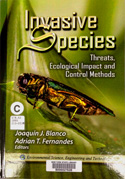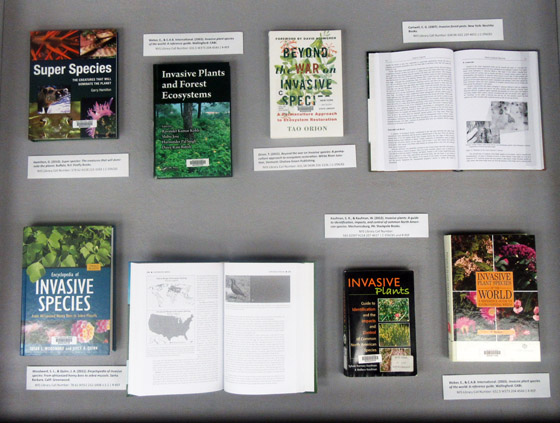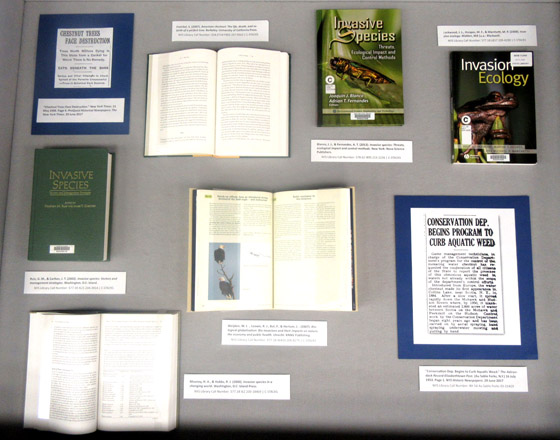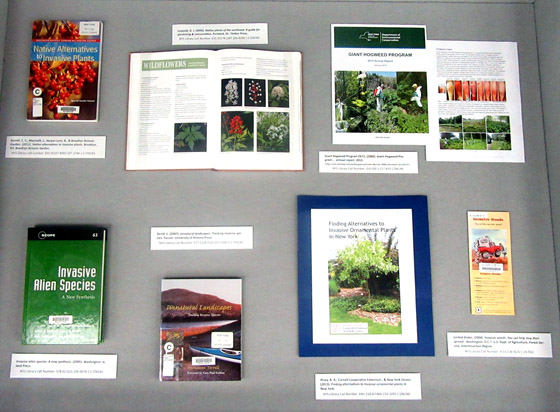
July 2017
New York's Invasive Species Awareness Week (ISAW) is July 9-15, 2017. Outreach initiatives across the state join forces to promote knowledge and understanding of invasive species and empower citizens to Stop the Invasion.

The NYS Library is celebrating ISAW with a book and informational exhibit during the month of July. The displays highlight some of the resources available in our collection including materials noting where invasive species were first identified or when they were first introduced not knowing the impact the nonnative species would have on the local ecosystem. Some of this information is found in periodicals from the early 1900s, and more current research is located in our collection of eJournals.
Want to get involved?

#NYInvasiveAwareness

Following is a list of the books and other resources exhibited, including the NYSL call number and, where applicable, links to online versions. You can also look these resources up in WorldCat![]() .
.
Alvey, A. A., Cornell Cooperative Extension., & New York (State). (2013). Finding alternatives to invasive ornamental plants in New York.
NYS Library Call Number: ENV 214-4 FINAI 216-1095 | ONLINE
Blanco, J. J., & Fernandes, A. T. (2012). Invasive species: Threats, ecological impact and control methods. New York: Nova Science Publishers.
NYS Library Call Number: 578.62 I895 213-2236 | C-STACKS
Burdick, A. (2006). Out of Eden: An odyssey of ecological invasion. New York: Farrar, Straus and Giroux.
NYS Library Call Number: 577.18 B951 205-7101 | C-STACKS
Burrell, C. C., Marinelli, J., Harper-Lore, B., & Brooklyn Botanic Garden. (2011). Native alternatives to invasive plants. Brooklyn, NY: Brooklyn Botanic Garden.
NYS Library Call Number: 635.95197 B969 207-1766 | C-STACKS
Cartwell, C. G. (2007). Invasive forest pests. New York: Novinka Books.
NYS Library Call Number: 634.96 I621 207-4651 | C-STACKS
"Conservation Dep. Begins to Curb Aquatic Weed." The Adirondack Record-Elizabethtown post. (Au Sable Forks, N.Y.) 16 July 1953. Page 1. NYS Historic Newspapers. 29 June 2017
NYS Library Call Number: NY 54 Au Sable Forks 93-31429
Access a digital copy at NYS Historic Newspapers![]()
Dept. of Agriculture, Forest Service, Intermountain Region. Invasive weeds : you can help stop their spread!
NYS Library Call Number: A 13.2:W 41/5 | US-DOC
Freinkel, S. (2007). American chestnut: The life, death, and rebirth of a perfect tree. Berkeley: University of California Press.
NYS Library Call Number: 634.9724 F865 207-9563 | C-STACKS
Giant Hogweed Program (N.Y.). (2000). Giant Hogweed Program ... annual report. 2015.
NYS Library Call Number: GIA 500-1 217-419 | ONLINE
Hamilton, G. (2010). Super species: The creatures that will dominate the planet. Buffalo, N.Y: Firefly Books.
NYS Library Call Number: 578.62 H218 211-1693 | C-STACKS
Invasive alien species: A new synthesis. (2005). Washington: Island Press.
NYS Library Call Number: 578.62 I621 206-6078 | C-STACKS
Johnson, W. S. (2012). Zooplankton of the Atlantic and Gulf Coasts: A Guide to Their Identification and Ecology. Johns Hopkins University Press.
NYS Library Call Number: 592.1776 J717 205-5594 2012 | R-REF
Kaufman, S. R., & Kaufman, W. (2012). Invasive plants: A guide to identification, impacts, and control of common North American species. Mechanicsburg, PA: Stackpole Books.
NYS Library Call Number: 581.62097 K214 207-4617 | C-STACKS and R-REF
Leland, J. (2005). Aliens in the backyard: Plant and animal imports into America. Columbia: University of South Carolina Press.
NYS Library Call Number: 578.62 L537 206-6164 | C-STACKS
Leopold, D. J. (2005). Native plants of the northeast: A guide for gardening & conservation. Portland, Or: Timber Press.
NYS Library Call Number: 635.95174 L587 205-8190 | C-STACKS
Lockwood, J. L., Hoopes, M. F., & Marchetti, M. P. (2008). Invasion ecology. Malden, MA [u.a.: Blackwell.
NYS Library Call Number: 577.18 L817 209-4290 | C-STACKS
Mooney, H. A., & Hobbs, R. J. (2000). Invasive species in a changing world. Washington, D.C: Island Press.
NYS Library Call Number: 577.18 I62 200-18469 | C-STACKS
Orion, T. (2015). Beyond the war on invasive species: A permaculture approach to ecosystem restoration. White River Junction, Vermont: Chelsea Green Publishing.
NYS Library Call Number: 631.58 O698 216-1136 | C-STACKS
Ruiz, G. M., & Carlton, J. T. (2003). Invasive species: Vectors and management strategies. Washington, D.C: Island.
NYS Library Call Number: 577.18 I621 204-3414 | C-STACKS
Sax, D. F., Stachowicz, J. J., & Gaines, S. D. (2005). Species invasions: Insights into ecology, evolution, and biogeography. Sunderland (Massachusetts: Sinauer Associates.
NYS Library Call Number: 577.18 S741 205-7635 | C-STACKS
Stop the Invasion 2017, 2017 New York Invasive Species Awareness Week - Fact Sheet
Terrill, C. (2007). Unnatural landscapes: Tracking invasive species. Tucson: University of Arizona Press.
NYS Library Call Number: 577.5218 T326 207-6345 | C-STACKS
United States. (n.d.). Check list of new plant introductions ready to be tested by cooperators. Washington, D.C: Office of Foreign Seed and Plant Introduction, Dept. of Agriculture.
NYS Library Call Number: 580.7 C514 205-5330 1916/17 | C-STACKS
United States. (2004). Invasive weeds: You can help stop their spread!. Washington, D.C.?: U.S.
Weber, E., & C.A.B. International. (2003). Invasive plant species of the world: A reference guide. Wallingford: CABI.
NYS Library Call Number: 632.5 W373 204-4549 | R-REF
Weijden, W. J. ., Leewis, R. J., Bol, P., & Hertum, J. (2007). Biological globalisation: Bio-invasions and their impacts on nature, the economy and public health. Utrecht: KNNV Publishing.
NYS Library Call Number: 577.18 W419 208-8275 | C-STACKS
Woodward, S. L., & Quinn, J. A. (2011). Encyclopedia of invasive species: From africanized honey bees to zebra mussels. Santa Barbara, Calif: Greenwood.
NYS Library Call Number: 578.62 W912 212-1498 V.1-2 | R-REF
Exhibit curated by Amy Peker